
University of Bristol

Vivienne Li
Email: electra200@hotmail.com
Molecule of the Month - July 2002
Spider Silk and Venom
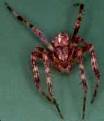
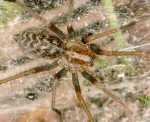 Spiders
are arthropods of the class arachnida along with ticks, mites and scorpions.
Of the arachnids, they are in the order Araneae which contains about
40,000 known species found worldwide except in Antarctica.
In the UK, there are more than 630 species including the garden spider,
Araneus diadematus, which is reknowned for spinning beautiful webs.
There are three housespider species: Tegenaria domestica, Tegenaria
atrica and Tegenaria parietina (the cardinal spider).
Spiders
are arthropods of the class arachnida along with ticks, mites and scorpions.
Of the arachnids, they are in the order Araneae which contains about
40,000 known species found worldwide except in Antarctica.
In the UK, there are more than 630 species including the garden spider,
Araneus diadematus, which is reknowned for spinning beautiful webs.
There are three housespider species: Tegenaria domestica, Tegenaria
atrica and Tegenaria parietina (the cardinal spider).
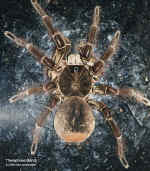 Spiders
have 8 legs, 8 simple eyes (4 pairs) and fangs with which they bite their prey. Most are less than 1 cm in length but the largest spider is the
bird-eating spider from South America with a body length of 9
cm. Males are often much smaller
than the females of the same species.
Spiders
have 8 legs, 8 simple eyes (4 pairs) and fangs with which they bite their prey. Most are less than 1 cm in length but the largest spider is the
bird-eating spider from South America with a body length of 9
cm. Males are often much smaller
than the females of the same species.
The general lifespan is about 1 year but males often die after mating and females after egg-laying. The eggs are encased in a silken sac woven by the female and after hatching, the young spiders molt until they reach adult size.
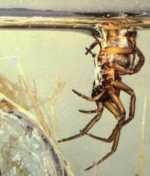 Spiders
are generally not social and are mostly terrestrial although some species
are aquatic, such as Argyroneta aquatica. Aquatic spiders breathe
underwater by trapping air bubbles with silk and dragging the bubbles with them.
Spiders
are generally not social and are mostly terrestrial although some species
are aquatic, such as Argyroneta aquatica. Aquatic spiders breathe
underwater by trapping air bubbles with silk and dragging the bubbles with them.
Spiders are predators and they play an important role in agricultural and domestic pest control since their main source of food is insects. Interest in how spiders can help humans has become increasingly important, especially the potential applications of natural or synthetic spider silk in the materials industry and spider venom in medicine.
Properties
Spider
silk is incredibly tough and is stronger by weight than steel.
Quantitatively, spider silk is five times stronger than steel of the same
diameter. It has been suggested that a Boeing 747 could be stopped in
flight by a single pencil-width strand and spider silk is almost as strong as
Kevlar, the toughest man-made polymer. It is finer than the human hair
(most threads are a few microns in diameter) and is able to keep its strength
below -40°C. The toughest silk is the dragline silk from the Golden
Orb-Weaving spider (Nephilia clavipes), so-called
because it uses silk of a golden hue to make orb webs.
Spider silk is also very elastic and capture silk (sticky silk for catching prey) remains unbroken after being stretched 2-4 times its original length. Spider silk is tougher, more elastic and more waterproof than silkworm silk so it could have a much wider range of applications. It is simple to see why spider silk is of such interest to materials chemists since new ultra-strong fibres based on the silk could be developed.
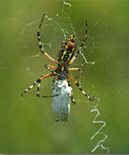 Uses
Uses
Spiders use silk for a variety of functions:
Swathing silk for the wrapping and immobilisation of prey.
Webs
for catching prey using sticky silk - it is elastic to prevent the prey from
rebounding off the web.
Draglines which are used to connect the spider to the web, as safety lines in case a spider should fall and as the non-sticky spokes of the web. Dragline silk is the strongest kind of silk because it must support the weight of the spider.
Parachuting or ballooning which is used to aid the dispersal of young and to find new areas as a food source. Silk is released and is caught by the wind to lift the spider up into the air - flying spiders!
Shelters such as burrows or nests
Egg-sacs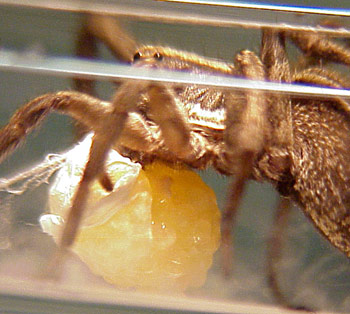
Mating: male spiders weave sperm webs on which they deposit sperm and subsequently transfer it to their front palps, ready for placing on a females genital organs. Some species make a web and coat it with sex pheromones to attract a mate.
Production
There are seven types of silk produced by seven silk glands. A single spider does not possess all seven glands but has at least three if it is male (dragline, attachment and swathing silk) or four if it is female. The additional one is for egg sac silk. The seven types of gland are:
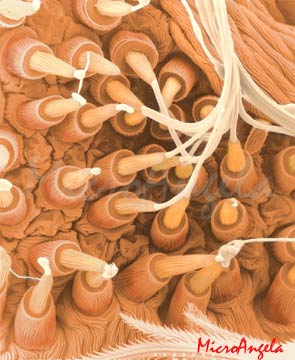
Achniform gland: swathing silk.
Cylindriform gland: egg sac silk.
Ampullate glands (major and minor): non-sticky dragline silk. Silk from the minor ampullate gland is only half as strong as that from the major gland.
Pyriform gland: attaching threads - attachment discs are made which anchor a thread to a surface or another thread.
Flagelliform gland: core fibres of sticky silk.
Aggregate gland: outer part of sticky silk - droplets of an adhesive substance are deposited along the threads.
Courtesy of Tina Carvlho, Microangela
The glands are located on the lower side of the abdomen (see diagram below) and contain a watery fluid known as 'dope'. This fluid passes through to the spinneret via a multitude of microscopic tubes where water recovery and solidification begins. Fluid from different glands can lead to the same spinneret so silk with specific properties required for a particular function can be produced. There are usually three pairs of spinnerets but this can vary between 1 and 4 pairs depending on the species. The substance exits through the spiggots which are mobile, finger-like protrusions and the resulting silk emerges as a solid. There are many spigots so many fibres are bound together like a cable. The diameter of a single fibre is controlled by the muscular action of a valve. The faster and tighter the strand is drawn, the stronger the silk.
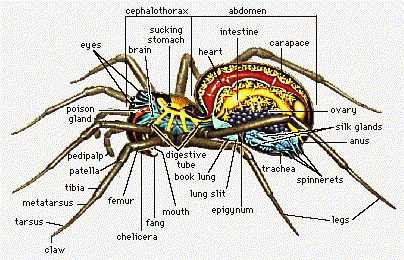
Picture from reference 11
Some interesting web facts:
Not all spiders weave webs.
Spiders do not stick to their own web because only the central spiral part of the web is sticky, not the spokes. The spider knows where to tread!
Webs lose their stickiness after about a day due to factors such as dust accumulation and exposure to air. In order to save energy the spider eats its own web before making a new one so the protein used for the silk threads is recycled.
The dragline silk of the Golden Orb-Weaving spider is the most studied in scientific research. Spider silk is a natural polypeptide, polymeric protein and is in the scleroprotein group which also encompasses collagen (in ligaments) and keratin (nails and hair). These are all proteins which provide structure. The protein in dragline silk is fibroin (Mr 200,000-300,000) which is a combination of the proteins spidroin 1 and spidroin 2. The exact composition of these proteins depends on factors including species and diet. Fibroin consists of approximately 42% glycine and 25% alanine as the major amino acids. The remaining components are mostly glutamine, serine, leucine, valine, proline, tyrosine and arginine. Spidroin 1 and spidroin 2 differ mainly in their content of proline and tyrosine.
Alanine  Glycine
Glycine

Structure of spidroin
Spidroin contains polyalanine regions where 4 to 9 alanines are linked together in a block. The elasticity of spider silk is due to glycine-rich regions where a sequence of five amino acids are continuously repeated. A 180° turn (b-turn) occurs after each sequence, resulting in a b-spiral. Capture silk, the most elastic kind, contains about 43 repeats on average and is able to extend 2-4 times (>200%) its original length whereas dragline silk only repeats about nine times and is only able to extend about 30% of its original length. There are also glycine-rich repeated segments which consist of three amino acids. These turn after each repeat to give a tight helix and may act as a transitional structure between the polyalanine and spiral regions.
Structure of spider silk
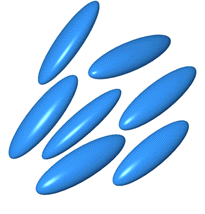 The
fluid dope is a liquid crystalline solution where the protein molecules can move
freely but some order is retained in that the long axis of molecules lie
parallel, resulting in some crystalline properties.
It is thought that the spidroin molecules are coiled in rod-shaped
structures in solution and later uncoil to form silk.
The
fluid dope is a liquid crystalline solution where the protein molecules can move
freely but some order is retained in that the long axis of molecules lie
parallel, resulting in some crystalline properties.
It is thought that the spidroin molecules are coiled in rod-shaped
structures in solution and later uncoil to form silk.
Picture from reference 2
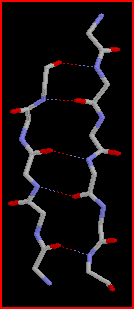
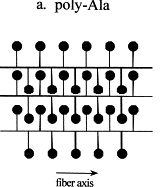 During
their passage through the narrowing tubes to the spinneret the protein molecules align and partial crystallisation occurs parallel to the fibre axis.
This occurs through self-assembly of the molecules where the polyalanine regions link together via hydrogen bonds to form pleated b-sheets (highly ordered crystalline regions).
These b-sheets
act as crosslinks between the protein molecules and imparts high tensile strength on the silk.
During
their passage through the narrowing tubes to the spinneret the protein molecules align and partial crystallisation occurs parallel to the fibre axis.
This occurs through self-assembly of the molecules where the polyalanine regions link together via hydrogen bonds to form pleated b-sheets (highly ordered crystalline regions).
These b-sheets
act as crosslinks between the protein molecules and imparts high tensile strength on the silk.
Ithis not purely coincidence that the major amino acids in spider silk are alanine and glycine. They are the smallest two amino acids and do not contain bulky side groups so are able to pack together tightly, resulting in easier formation of the crystalline regions.
The crystalline regions are very hydrophobic which aids the loss of water during solidification of spider silk. This also explains why the silk is so insoluble - water molecules are unable to penetrate the strongly hydrogen bonded b-sheets.
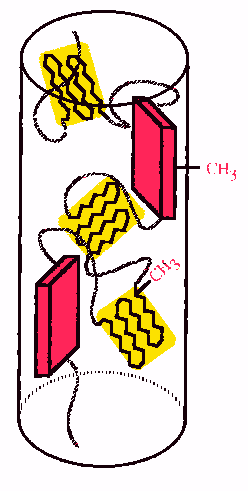 The
glycine-rich spiral regions of spidroin aggregate to form amorphous areas and
these are the elastic regions of spider silk.
Less ordered alanine-rich crystalline regions have also been identified and these are thought to connect the b-sheets
to the amorphous regions.
Overall, a generalised structure
of spider silk is considered to be crystalline regions in an amorphous matrix.
Kevlar has a similar structure.
The
glycine-rich spiral regions of spidroin aggregate to form amorphous areas and
these are the elastic regions of spider silk.
Less ordered alanine-rich crystalline regions have also been identified and these are thought to connect the b-sheets
to the amorphous regions.
Overall, a generalised structure
of spider silk is considered to be crystalline regions in an amorphous matrix.
Kevlar has a similar structure.
It is not entirely clear how the protein molecules align and undergo self-assembly to form silk but it may involve mechanical and frictional forces that arise during passage through the spider’s spinning organs.
Image from reference 10
The pink blocks are highly ordered b-sheets and yellow regions are less ordered crystalline areas.
Applications of Spider Silk
Humans have been making use of spider silk for thousands of years. The ancient Greeks used cobwebs to stop wounds from bleeding and the Aborigines used silk as fishing lines for small fish. More recently, silk was used as the crosshairs in optical targeting devices such as guns and telescopes until World War II and people of the Solomon Islands still use silk as fish nets.
Current
research in spider silk involves its potential use as an incredibly strong and
versatile material. The interest in
spider silk is mainly due to a combination of its mechanical properties and the
non-polluting way in which it is made. The
production of modern man-made super-fibres such as Kevlar involves petrochemical
processing which contributes to pollution.
Kevlar is also drawn from concentrated sulphuric acid.
In contrast, the production of spider silk is completely environmentally
friendly. It is made by spiders at
ambient temperature and pressure and is drawn from water.
In addition, silk is completely biodegradable. If the production of spider silk ever becomes industrially
viable, it could replace Kevlar and be used to make a diverse range of items
such as:
Bullet-proof clothing
Wear-resistant lightweight clothing
Ropes, nets,
seat belts, parachutes
Rust-free panels on motor vehicles or boats
Biodegradable bottles
Bandages, surgical thread
Artificial tendons or ligaments, supports for weak blood vessels.
However the production of spider silk is not simple and there are inherent problems. Firstly spiders cannot be farmed like silkworms since they are cannibals and will simply eat each other if in close proximity. The silk produced is very fine so 400 spiders would be needed to produce only one square yard of cloth. The silk also hardens when exposed to air which makes it difficult to work with.
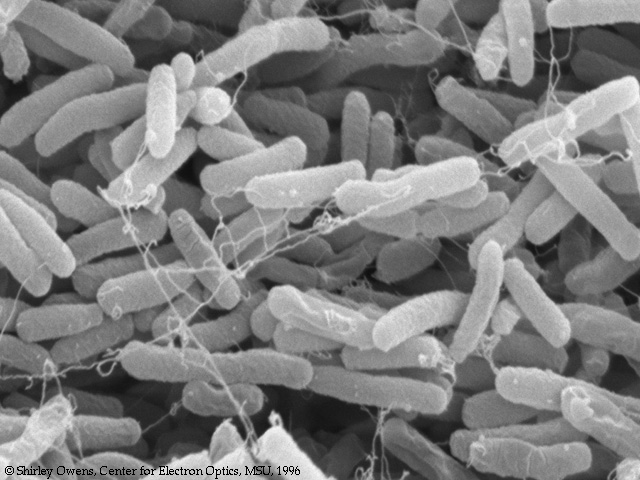 The alternative approach is to learn how spiders spin silk and then copy them to make synthetic spider silk. The silk itself would also have to be artificially made.
Chemical synthesis of spider silk is not viable at present due to the lack of knowledge about silk structure so the replication of silk is currently
being achieved using genetic engineering. Randolph V. Lewis, Professor of Molecular Biology at the University of Wyoming in Laramie, has inserted silk genes into Escherichia coli bacteria to successfully produce the repeated segments of spidroin 1 and spidroin 2.
The alternative approach is to learn how spiders spin silk and then copy them to make synthetic spider silk. The silk itself would also have to be artificially made.
Chemical synthesis of spider silk is not viable at present due to the lack of knowledge about silk structure so the replication of silk is currently
being achieved using genetic engineering. Randolph V. Lewis, Professor of Molecular Biology at the University of Wyoming in Laramie, has inserted silk genes into Escherichia coli bacteria to successfully produce the repeated segments of spidroin 1 and spidroin 2.
 More recently, Nexia Biotechnologies Inc in Montreal, Canada have inserted silk genes into goats to produce silk proteins in their milk. This is hoped to be a better method because protein from bacteria is not as strong due to faulty crosslinking of the proteins and hard white lumps can form. Milk production in mammary glands is similar to silk protein production in spiders so it is thought that proper protein crosslinking could occur in goats.
More recently, Nexia Biotechnologies Inc in Montreal, Canada have inserted silk genes into goats to produce silk proteins in their milk. This is hoped to be a better method because protein from bacteria is not as strong due to faulty crosslinking of the proteins and hard white lumps can form. Milk production in mammary glands is similar to silk protein production in spiders so it is thought that proper protein crosslinking could occur in goats.
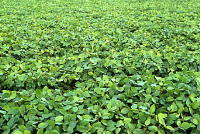 It has been suggested that the whole gene sequence might not be needed to produce useful spider silk. Prospects include possible gene insertion into fungi and soya plants. It may also be possible to alter the silk genes for specific purposes.
For example altering the genes responsible for camouflaging spider silk in nature could lead to a range of silk colours.
It has been suggested that the whole gene sequence might not be needed to produce useful spider silk. Prospects include possible gene insertion into fungi and soya plants. It may also be possible to alter the silk genes for specific purposes.
For example altering the genes responsible for camouflaging spider silk in nature could lead to a range of silk colours.
Photograph by Carolyn Merchant
There are still problems with developing synthetic spider silk production. An artificial method of spinning silk remains a mystery. Spider spinning dope is approximately 50% protein but this is too high a concentration to use industrially since the fluid would be too viscous to allow efficient spinning. The silk is also insoluble in water but this can be overcome by attaching soluble amino acids such as histidine or arginine to the ends of the protein molecules. In addition, the silk coagulates if the fluid is stirred so it would have to be redissolved. Current research focuses around these problems and a possible solution would be to adapt the composition of silk proteins to alter its properties. Research is still in its early stages but unravelling the secrets of spider silk is underway.
 Almost
all spiders possess venom.
They inject it into their prey through fangs to induce paralysis and
immobilisation so that it can either be eaten right away or kept for later.
Digestive fluids containing enzymes are regurgitated onto or into the
prey and the digestive juices are subsequently ingested.
Contrary to popular belief, the digestive fluids are not injected into
the prey through the fangs but after the prey has been immobilised.
Almost
all spiders possess venom.
They inject it into their prey through fangs to induce paralysis and
immobilisation so that it can either be eaten right away or kept for later.
Digestive fluids containing enzymes are regurgitated onto or into the
prey and the digestive juices are subsequently ingested.
Contrary to popular belief, the digestive fluids are not injected into
the prey through the fangs but after the prey has been immobilised.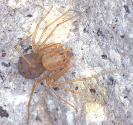
Spider poison is not always injected into other organisms. Some spider species have toxins on body hairs that are scraped onto predators to cause eye and skin irritation or temporary blindness, allowing the spider to escape. Spitting spiders spray glue-venom to capture their prey.
Most spiders are actually too small to bite humans since their fangs are unable to penetrate the skin and of those that do break the skin. Out of about 40,000 species only 20-30 have venom potent enough to cause harm to humans and they only bite if they feel threatened. The actual effect of the venom depends largely on age, health and amount injected. Most venom does not cause a severe reaction because insufficient amounts are injected but temporary skin discoloration and swelling may occur. Death is extremely rare and is usually caused by a severe allergic reaction or immune deficiency to the venom rather than the action of the poison itself. Children and the elderly are more susceptible to extreme reactions.
Two of the most poisonous spiders include:
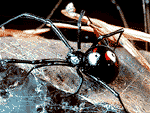 Black widow spider (Latrodectus mactans):
Its venom is 15 times more potent than rattlesnake venom of equal weight.
Only the female spiders pose a threat; venom from male black widows is harmless to humans. The venom is a neurotoxin and affects the nervous system. Symptoms include severe chest and abdominal pain, raised blood
pressure, breathing problems, heart palpitations, nausea, sweating, excessive salivation and a high pulse rate.
Death is very uncommon but when it does occur it is usually due to suffocation caused by the immobilisation of muscles required for breathing.
Black widow spider (Latrodectus mactans):
Its venom is 15 times more potent than rattlesnake venom of equal weight.
Only the female spiders pose a threat; venom from male black widows is harmless to humans. The venom is a neurotoxin and affects the nervous system. Symptoms include severe chest and abdominal pain, raised blood
pressure, breathing problems, heart palpitations, nausea, sweating, excessive salivation and a high pulse rate.
Death is very uncommon but when it does occur it is usually due to suffocation caused by the immobilisation of muscles required for breathing.
Brown recluse spider (Loxosceles reclusa): Symptoms occur 6-8 hours after the initially painless bite. The venom is necrotic and affects cellular tissue. The bite firstly appears as a mosquito bite but soon becomes more swollen and painful. Tissue death and ulceration occurs to form a lesion up to 10 cm in diameter. This lesion can take months to heal and antibiotics must be taken to prevent a secondary bacterial infection. The most severe wounds occur in areas where there is a higher fat content such as the thighs, abdomen and buttocks. Scarring can occur and in some cases skin grafts and plastic surgery may be needed.

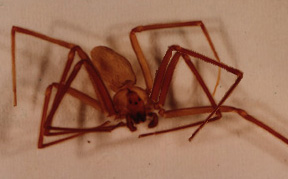
Generally, spiders that live on webs possess neurotoxic venom whereas those that do not live on webs have necrotic venom.
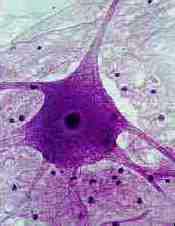 The
majority of spiders possess neurotoxic venom.
These neurotoxins are multicomponent but contain three main groups of
toxic compounds:
The
majority of spiders possess neurotoxic venom.
These neurotoxins are multicomponent but contain three main groups of
toxic compounds:
Low Mr polyamines (Mr less than 1000)
Polypeptides (Mr 3000-10,000)
High Mr proteins (Mr more than 10,000)
Other
venom components include inorganic ions and salts, free acids (eg. lactic acid),
glucose, nucleic acids, free amino acids and biogenic amines.
The exact role of these is unknown but they are thought to aid the
stability, delivery and effectiveness of the toxins.
The excitability of the cell membrane and the transmission of electrical signals across a synapse are very important in the function nerve tissue. As a result, neuronal receptors, ion channels or membrane proteins involved in neurotransmitter release are attacked by most venoms.
Picture from reference 12
Polyamines
The structure of a spider polyamine consists of a hydrophobic, aromatic carboxylic acid region connected to a hydrophilic polyamine amide chain.

Polyamines work by blocking neuromuscular junctions in insects to prevent the release of the main neurotransmitter, glutamate, resulting in paralysis. These toxins tend to be specific for insects and not vertebrates.
Polypeptides
These attack ion channels and are the major components of spider toxins. Ion channels are proteins situated on the nerve cell membrane, through which ions can pass to move across the membrane. The channels control the electrical potential of the membrane and ionic balance so they are vital in neurotransmitter release. The different types of ion channel and examples of the toxins which affect them are discussed below.
Calcium channels are important in cardiac and muscular function. Voltage-dependent calcium channels are blocked by w-agatoxins (30-40 amino acid peptides) from Agelenopsis aperta which causes muscular paralysis due to prevention of neurotransmitter release. w-Agatoxins can be selective for calcium channels of different animal groups such as mammals, birds and insects.
Sodium channels of the voltage-dependent kind are present in nerve and muscle cells. They are targeted by m-agatoxins (36-37 amino acid peptides) which increase the amount of Na+ moving across the cell membrane to cause excessive presynaptic neural stimulation and massive neurotransmitter release. This causes hyperstimulation of post-synaptic receptors resulting in paralysis. These channels are attacked in the same way by d-atracotoxins from the Australian funnel-web spiders Atrax robustus and Hadronyche versutus which show significant toxicity towards humans.
Potassium channels control the duration and frequency of electrical signals so it is possible that they influence cardiac function. Voltage-dependent potassium channels are targeted by hanatoxins (35 amino acid peptides) from the Chile Rose tarantula (Grammastola spatulata). It is thought that they work together with sodium channel toxins to induce massive neurotransmitter release and paralysis.
Polypeptide toxins all have the same basic structure. A single polypeptide molecule is folded so that a b-sheet consisting of three strands is made. The overall structure of the peptide is termed a ‘cysteine knot’.
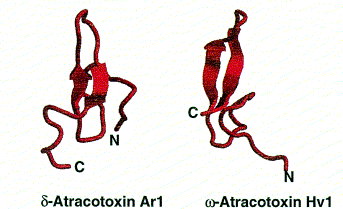
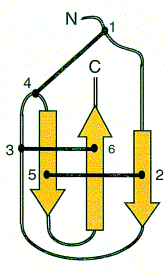
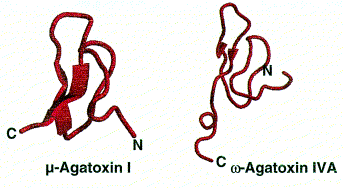
Images from reference 8 Structures of polypeptide toxins and schematic diagram of a cysteine knot
Proteins
An example of a neurotoxic protein is a-latrotoxin from the black widow spider. It is highly toxic to vertebrates and causes massive neurotransmitter release.
Enzyme proteins are used in necrotoxins. The active enzyme in brown recluse spider venom is sphingomyelinase D which causes the degradation of cell membranes and the development of painful lesions.
Interest in potential agricultural and medical uses of spider venom is largely due to its selectivity in species and site of action. Current research centres around exploring the development of pesticides and drugs for treating cardiac patients.
Pesticides
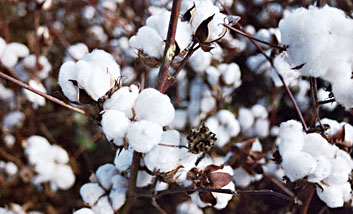
 Components
in the neurotoxic venom of an Australian funnel-web spider have been found to be
specific for insects such as cockroaches, crickets, fruit-flies and the Helicoverpa
armigera moth which destroys cotton crops.
Targeting specific species prevents the accidental killing of other
insects.
This selectivity also means that the pesticide is harmless to other
organisms so there would be no danger if it entered the food chain.
The compounds in venom are environmentally friendly and the development of resistance to a spider venom pesticide would be slow.
Traditional chemical pesticides do not tend to be species specific, are toxic to humans in large amounts and insects develop resistance towards them relatively fast so it is easy to see why pesticides based on spider venom are attractive.
Components
in the neurotoxic venom of an Australian funnel-web spider have been found to be
specific for insects such as cockroaches, crickets, fruit-flies and the Helicoverpa
armigera moth which destroys cotton crops.
Targeting specific species prevents the accidental killing of other
insects.
This selectivity also means that the pesticide is harmless to other
organisms so there would be no danger if it entered the food chain.
The compounds in venom are environmentally friendly and the development of resistance to a spider venom pesticide would be slow.
Traditional chemical pesticides do not tend to be species specific, are toxic to humans in large amounts and insects develop resistance towards them relatively fast so it is easy to see why pesticides based on spider venom are attractive.
Prevention of Atrial Fibrillation
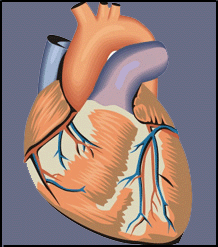
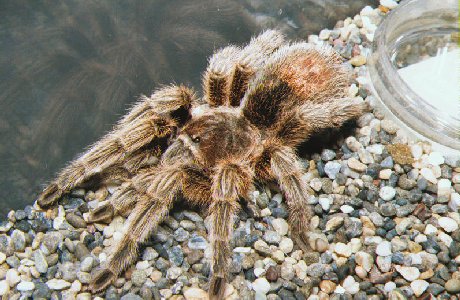 The
venom of the Chile Rose tarantula (Grammostola spatulata) from South America contains an active protein, GsMtx-4, which
blocks ion channels that are stretch activated.
These channels are therefore sensitive to muscle contraction and blood pressure and play an important role in co-ordinating a heartbeat.
A heart attack causes these ion channels to open and release chemicals which interfere with the heart rhythm leading to atrial fibrillation.
Fibrillation is when the upper heart chambers (the atria) contract rapidly and prevent sufficient blood from entering the lower chambers (the
venticles). It is fibrillation which often causes the death of a heart attack victim, not the attack itself so GsMtx-4 could be utilised in a potentially life-saving drug which prevents fibrillation.
GsMtx-4 is ineffective on the normal unstretched heart so side effects should be small or even non-existent.
The venom from the Chile Rose spider is also harmless to humans which constitutes an extra safety precaution.
The
venom of the Chile Rose tarantula (Grammostola spatulata) from South America contains an active protein, GsMtx-4, which
blocks ion channels that are stretch activated.
These channels are therefore sensitive to muscle contraction and blood pressure and play an important role in co-ordinating a heartbeat.
A heart attack causes these ion channels to open and release chemicals which interfere with the heart rhythm leading to atrial fibrillation.
Fibrillation is when the upper heart chambers (the atria) contract rapidly and prevent sufficient blood from entering the lower chambers (the
venticles). It is fibrillation which often causes the death of a heart attack victim, not the attack itself so GsMtx-4 could be utilised in a potentially life-saving drug which prevents fibrillation.
GsMtx-4 is ineffective on the normal unstretched heart so side effects should be small or even non-existent.
The venom from the Chile Rose spider is also harmless to humans which constitutes an extra safety precaution.
Prevention of Brain Damage
 Oxygen deprivation caused by events such as stroke or excessive smoke inhalation can
result in nerve cell damage in the brain.
Glutamate is a neurotransmitter in the human brain and large amounts of it are released by these damaged neurons causing the death of neighbouring nerve
cells.
The Holena curta funnel-web spider produces a venom containing the active ingredient HF-7 which blocks receptors on the nerve cell membranes and
prevents glutamate production.
A drug developed using this compound could therefore limit brain damage for stroke victims.
Oxygen deprivation caused by events such as stroke or excessive smoke inhalation can
result in nerve cell damage in the brain.
Glutamate is a neurotransmitter in the human brain and large amounts of it are released by these damaged neurons causing the death of neighbouring nerve
cells.
The Holena curta funnel-web spider produces a venom containing the active ingredient HF-7 which blocks receptors on the nerve cell membranes and
prevents glutamate production.
A drug developed using this compound could therefore limit brain damage for stroke victims.
Sources
Hinman, M.B., Jones, J.A. and Lewis, V.R. Synthetic spider silk: a modular fibre. Trends in Biotechnology, 2000, 18 (9) 374-379.
Hayashi, C.Y., Shipley, N.H. and Lewis, R.V. Hypotheses that correlate the sequence, structure, and mechanical properties of spider silk proteins. Int. J. Biol. Macromolecules, 1999, 24 (2-3), 265-270.
Vollrath, F. and Knight, D.P. Liquid crystalline spinning of spider silk. Nature, 2001, 410 (6828) 541-548
Tatham, A.S. and Shewry, P.R. Elastomeric proteins: biological roles, structures and mechanisms. Trends in Biochemical Science, 2000, 25 (11) 657-571.
Parkhe, A.D. et al. Structural Studies of Spider Silk Proteins in the Fiber. Journal of Molecular Recognition, 1997, 10 (1) 1-6.
Rathore, O. and Sogah, D.Y. Self-Assembly of b-Sheets into Nanostructures by Poly(alanine) Segments Incorporated in Multiblock Copolymers Inspired by Spider Silk. J. Am. Chem. Soc., 2001, 123 (22) 5231-5239.
Rash, L.D. and Hodgson, W.C. Pharmacology and biochemistry of spider venoms. Toxicon, 2002, 40 (3) 225-254.
Escoubas, P., Diochot, S. and Corzo, G. Structure and pharmacology of spider venom neurotoxins. Biochimie, 2000, 82 (9-10) 893-907.
Bode, F., Sachs, F. and Franz, M.R. Tarantula peptide inhibits atrial fibrillation: A peptide from spider venom can prevent the heartbeat from losing its rhythm. Nature, 2001, 409 (6816) 35-36.
Simmons, A.H., Michal, C.A. and Jelenski, L.W. Molecular Orientation and Two-Component Nature of the Crystalline Fraction of Spider Dragline Silk. Science, 1996, 271 84-87.
Image from http://www.gen.umn.edu/courses/1135/lab/reflexlab/synapse.html
Useful Links
The Spider's Web Part 1 and Part 2
Structure, Function, and Biosynthesis of a D-Amino Acid-containing Peptide, w-Agatoxin-TK
Necrotic Arachnidism in Australia
![]() Back to Molecule of the Month page. [DOI:10.6084/m9.figshare.5368588]
Back to Molecule of the Month page. [DOI:10.6084/m9.figshare.5368588]